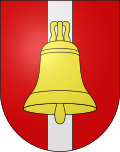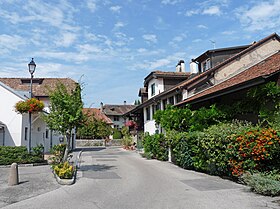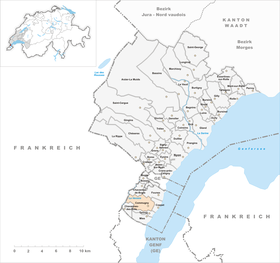Commugny
| Commugny | |
|---|---|
| State : |
|
| Canton : |
|
| District : | Nyon |
| BFS no. : | 5711 |
| Postal code : | 1291 |
| Coordinates : | 502 977 / 130689 |
| Height : | 419 m above sea level M. |
| Height range : | 395–485 m above sea level M. |
| Area : | 6.53 km² |
| Residents: | 2874 (December 31, 2018) |
| Population density : | 440 inhabitants per km² |
| Website: | www.commugny.ch |
|
Commugny |
|
| Location of the municipality | |
Commugny is a municipality in the Nyon district in the canton of Vaud in Switzerland .
geography

Commugny is 419 m above sea level. M. , in the extreme southwest of Vaud, 13 km north of the city of Geneva (as the crow flies). The village extends on the ridge that flanks the lower Lake Geneva on its west side, on both sides of the Greny brook .
The 6.5 km² municipal area covers a section of the ridge west of Lake Geneva. The eastern part of the municipality is located in the catchment area of the Greny, a brook that receives part of its water through a discharge from the Versoix near Bogis-Bossey . The Greny flows in a weak valley through Commugny. To the west, the municipality extends to the ridge and over the forest area Bois de Portes , in which at 483 m above sea level. M. the highest point of Commugny is reached, up to the strongly meandering course of the Versoix in the area of the Pré-Nouveau marshland . In 1997, 17% of the municipal area was in settlements, 20% in forests and woodlands, 62% in agriculture and a little less than 1% was unproductive land.
Some individual farms belong to Commugny. Neighboring municipalities of Commugny are Chavannes-des-Bois , Tannay , Coppet , Founex and Chavannes-de-Bogis in the canton of Vaud and Grilly and Divonne-les-Bains in neighboring France .
population
With 2874 inhabitants (as of December 31, 2018), Commugny is one of the medium-sized municipalities in the canton of Vaud. Of the residents, 65.9% are French-speaking, 17.0% English-speaking and 8.3% German-speaking (as of 2000). The population of Commugny was 249 in 1850 and 308 in 1900. After 1960 (439 inhabitants) a rapid increase in population began with a fivefold increase in the number of inhabitants within 40 years.
economy
Commugny was mainly an agricultural village until the second half of the 20th century . On the outskirts of Commugny there are some smaller wine-growing areas . Thanks to the fertile soil, most of the remaining agricultural area is cultivated . There are other jobs in telecommunications, local businesses and the service sector. In the last few decades Commugny has developed into a residential community. There are extensive single-family houses and villa quarters, especially on the northern outskirts. The settlement area of Commugny is loosely combined with that of Tannay, Coppet and Founex. Most of the employed people are commuters (around 75%) who work mainly in Geneva .
traffic
The community is very well developed in terms of transport. It is located on the main road from Versoix to Divonne-les-Bains . The Coppet motorway junction on the A1 (Geneva-Lausanne) is only 3 km from the village. The Postbus course, which runs from Nyon to Coppet , connects Commugny to the public transport network.
history
The municipality was already settled in Roman times, which is evidenced by the remains of a villa from that time. There was also a settlement here during the Burgundian period . A first church was built in the 6th and 7th centuries. The Commugny area was probably donated to the Saint-Maurice Abbey in the 9th century .
The first written mention of the place took place in 1018 under the name Communiacum ; In 1712 the spelling Commagny appeared and in 1778 Commugni . The place name goes back to the Latin word communis ( community ). Since the 10th century, Commugny and its surroundings formed an enclave in the county of Geneva, which repeatedly gave rise to disputes. This was probably the reason why the Abbot of Saint-Maurice Commugny sold to Peter of Savoy in 1257 . In 1271 the community came under the rule of Coppet, which ended the relative independence of Commugny.
With the conquest of Vaud by Bern in 1536, the village came under the administration of the Nyon Bailiwick . After the collapse of the Ancien Régime , Commugny belonged to the canton of Léman from 1798 to 1803 during the Helvetic Republic, which then became part of the canton of Vaud when the mediation constitution came into force . In 1798 it was assigned to the Nyon district.
In 1905, Jean Lanfray murdered his pregnant wife and two children in Commugny, which led to the ban on absinthe .
Attractions
The Saint-Christophe church stands on the site of the former Roman villa. The foundation stone for the first church was laid in the 6th century . The current building dates largely from the 15th century, the bell tower was built in 1481 based on the Romanesque tradition. The nave has seven side chapels; In the northern choir chapel there are finely carved capitals. Excavations have brought to light the remains of the Roman mansion, including important wall paintings from the 1st century. Parts of it are preserved in the rectory, which was built in 1789. The so-called Château de Marnex, a fortified house, was built around 1450. Town centers, villas and farmhouses from the 17th to 19th centuries have been preserved in the center and the surrounding area.
Web links
- Official website of the Commune of Commugny (French)
- Christophe Henny: Commugny. In: Historical Lexicon of Switzerland .
Individual evidence
- ↑ Permanent and non-permanent resident population by year, canton, district, municipality, population type and gender (permanent resident population). In: bfs. admin.ch . Federal Statistical Office (FSO), August 31, 2019, accessed on December 22, 2019 .
- ^ Barnaby Conrad: Absinthe: History in a Bottle. Chronicle Books, 1997.




